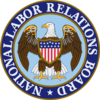Coercion of employees (Section 8(b)(1)(A))
Employees have the right to unionize and to join together to advance their interests as employees. They also have the right to refrain from such activity. It is unlawful for a labor union to restrain or coerce employees in the exercise of their rights. For example, you may not restrict employee-members' freedom to resign from the union, or fine an employee-member for filing a decertification petition.
Section 8(b)(1)(A) of the Act makes it unlawful for a labor organization or its agents "to restrain or coerce employees in the exercise of the rights guaranteed them in Section 7 of the Act, provided that this paragraph shall not impair the right of a labor organization to prescribe its own rules with respect to the acquisition or retention of membership therein." For example, you may not
- Use violence or threats of violence to coerce employees. This includes violence directed at nonemployees, if employees are present or will hear about it.
- Breach your duty to fairly represent employees. Although your conduct is entitled to a wide range of reasonableness, you may not act arbitrarily, discriminatorily, or in bad faith. "Bad faith" means fraud, deceit, or dishonesty.
- Photograph or videotape employees engaged in activity protected by Section 7 of the Act, unless you have a legitimate reason to do so and have communicated that reason to the employees (unless it's self-evident) in a timely manner.
- Discipline a member for filing unfair labor practice charges.
- Discipline a member for refusing to engage in unlawful or unprotected activity.
- Fine a member for filing a decertification petition.
- Discipline a member for testifying against other members in a grievance meeting or an arbitration proceeding.
- Fine employees who are no longer members.
- Restrict member's freedom to resign.
- Impose discipline on a member that impacts his employment.
- Require that fines be paid before you will accept payment of dues under a union-security agreement.
- Fail to give an employee notice and a reasonable opportunity to become current on his dues before seeking his discharge under a union-security agreement.
- Cause an employer to discharge an employee under a union-security agreement if you failed to give the employee notice of his right under Communication Workers of America v. Beck, 487 U.S. 735 (1988), to be a nonmember and object to paying the portion of his dues that is not germane to your representative duties.
- Expel an employee from membership and then threaten to cause his discharge for nonpayment of full membership dues.
- Accept recognition from an employer if you do not enjoy the uncoerced support of a majority of the employees you seek to represent.
- Enter into a collective-bargaining agreement if you do not enjoy the uncoerced support of a majority of the employees you seek to represent. Under Section 8(f) of the Act, however, you may enter into a collective-bargaining agreement with an employer in the building and construction industry without regard to your majority or minority status.


